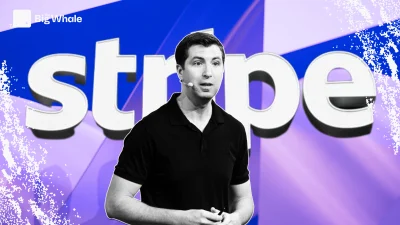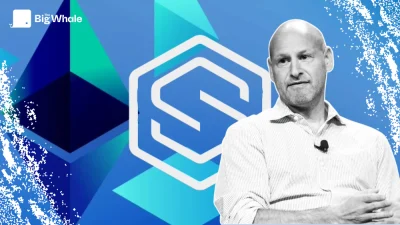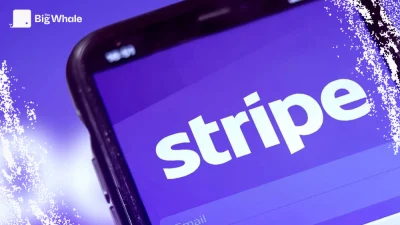Why are you coming? Is it for a specific reason or just to meet some partners in Paris?
As you know, we made a big announcement on 1 July about issuing USDC and EURC under MICA regulations. We wanted to allow Europe to take its summer break (laughs) , and now we're back to do a European tour of major cities for several weeks. I'm not doing everything personally, but there are several weeks of touring.
In which cities?
Paris, Barcelona because of the event there this week, Berlin, then London and Switzerland. These are the first stages.
Why Switzerland?
There's a lot going on in Switzerland. It doesn't necessarily have to do directly with MICA, but there are a lot of traditional financial institutions, digital asset companies, crypto companies and other players. So it's a place where there's a lot of activity.
Could you launch the Swiss franc on blockchain?
That's not a priority for us. But yes, we're basically here doing marketing, business development, meeting media, and we have a lot of new initiatives we're working on now that issuance under MICA is in place.
In July, you became the first stablecoin issuer to comply with MICA. What did you think of the regulatory process?
It took several years and a lot of hard work. We had to work with the various stakeholders who ultimately had to define the final rules for issuing stablecoins. But we also had to manage the complexity of a global stablecoin like the USDC and the question of how to have regional issuance, with regional reserves alongside global issuance and global reserves. So that created a lot of new things to work on, which we did. But it wasn't easy, it required a lot of work from our local team, our European team and our global team. It was really very important.
The EURC reserve contains deposits in European banks, doesn't it?
Yes, and so does the USDC reserve.
So, depending on the estimated amount of USDC held by European entities, you hold reserves in European banks. If I buy USDC on Bitstamp from Paris, the reserve of this stablecoin will be in European banks?
Exactly, that's right.
But I don't understand one thing. How do you differentiate between USDC with deposits in US banks and USDC with deposits in European banks?
It's fungible.
It's fungible, how do you mean?
Yes, it's fungible. We designed a model in collaboration with the regulators, which is based on an issue model. So, first of all, Circle only offers direct minting and redemption at an institutional level. However, as part of MICA, we are also required to be the recourse in the event of a final redemption. So an individual can come to us to buy back, but most of the time you will use Coinbase, Kraken, Bitpanda, Bitstamp or other platforms. We issue and redeem from Circle France, our regulated entity in Europe, and from Circle Internet Financial in the US, which is a separate entity. What we have agreed with the regulators is a framework for calculating each day how many USDCs are held by people in Europe. Then we rebalance the reserve. For example, if it looks like there is now an extra 100 million USDC in Europe, we move 100 million dollars of assets to a European bank.
How many banking partners do you have in Europe?
I don't think we disclose the total number, but we have several partners and we are constantly adding.
Less than 10?
Less than 10, yes.
Are there any French banks?
We haven't publicly announced any French banks yet...
"We have, I think, the best banking relationships in the whole industry" What is your overall relationship with French banks? Because in France, people say that French banks don't like crypto. It's very difficult for crypto companies to establish a banking relationship. What about you?
I think we've been able to establish solid banking relationships thanks to who we are, our regulation, our compliance history and the nature of our product, which is a fiat digital currency system. We have, I think, the best banking relationships in the industry. We work with a number of the world's leading systemic banks and we're adding more to our platform. For example, last week we launched USDC into the Brazilian banking system with 24/7 rails via BTG Pactual, which is the largest commercial and investment bank in Latin America. So we've managed to establish that, and I think you'll see that we'll also be working with globally important banks based in Europe and with some of the larger regional banks, like those in France.
This summer, you tweeted that iPhone users would soon be able to use "Tap to Pay" to make payments in USDC. Is Circle working directly on this feature or will other start-ups develop it?
I made this post which has been seen a million times, then I made another post to clarify what I was saying. Circle is not working directly with Apple. The important point is that now, with the latest version of the iPhone and iOS 18, Apple has opened up NFC functionality to third-party wallet developers. This means that, for example, a Coinbase or Phantom wallet or your favourite wallet can now, if requested, get permission from Apple to use NFC. Then you'll need a payment processor that handles point-of-sale payments and supports blockchain payments. But I think there's a lot of interest for wallet developers, payment processors and merchants, because it enables direct digital payments without the associated traditional costs.
Do you think this Tap to Pay functionality is a revolution for crypto payments?
Yes, I think it's very important. The long-term potential of stablecoins is their use in all fiduciary transactions, whether it's tokenising a bond, enabling payments between AI agents with microtransactions, or making a direct payment to another person via a wallet in self-custody.
You said in Singapore that stablecoins were moving more and more towards payment instruments rather than trading instruments. Do you have any indicators to back that up?
Yes, that's what we see in the on-chain data. We don't see every transaction, or every person using stablecoins, but we have seen a steady growth over the last few years in the percentage of USDC that is not directly associated with DeFi or exchanges, but rather with what we call the "long trend". These are smaller holders who use digital dollars as a store of value and to carry out smaller transactions. We also see this in our business development activities. A lot of start-ups, especially in emerging and developing markets, are building products for payments, savings, cross-border payments, cross-border payments for SMEs, and even trade finance. These are the main activities. Many of our regional OTC (Over-The-Counter) partners report that more and more of their customers are SMEs who are using stablecoins to manage cross-border settlements more quickly and without the costs and inefficiencies of local currencies, the local banking system and the international banking system. We obtain this information anecdotally, both through on-chain data and via our specific partners. It's still modest compared to the size of this market, but it represents the start of a change that we expect to grow.
What do you think of crypto payment cards with Visa and Mastercard? Is this a good solution for crypto payments?
I think it's useful at a time when many people are storing value in cryptos and stablecoins. Being able to use that stored value with existing payment networks is handy. If my preference is to keep my money in Bitcoin or USDC, I should be able to use it directly without having to sell it, convert it to fiat, transfer it to a bank account and then use a card. We've worked with Mastercard and Visa to enable them to use USDC as a settlement system within their networks. We're seeing a lot of Web3 wallet products and crypto neobanks launching Visa or Mastercard debit cards linked to a stablecoin balance. That's a very positive thing. However, in the longer term, in the next five to ten years, what I've been talking about with "Tap to Pay" could allow you to use a Web3 wallet with EURC, and directly pay a merchant here in Paris who accepts EURC. The merchant would receive euros instantly, with no credit card charges. It's a small example, but it shows that in the future, companies will have crypto wallets, they will all be on-chain. They will use digital tokens for incentives, rewards, or even tokenised bonds, and use DeFi as a financial system. That's the vision we're pursuing, not just at Circle, but across the industry.
"We believe in full reserve currency, which is a form of money that is not lent but is fully available" Do you see Circle as the bank of the future?
No, we don't see ourselves as a bank. Banks, by definition, are businesses that take risks. They receive a dollar and invest it ten times over, in other words they are risk managers and investment managers, regulated specifically for that purpose. That's not what we do. We believe in full reserve money, i.e. a form of money that is not lent but is fully available, and we are building market infrastructures on the scale of the Internet to enable this. Historically, banks combined lending and payment services. We are separating these two functions. We are building a separate payment system. So whether you call it a payments bank or something else, there are a number of concepts for that, but I want to be careful with the terms because we're not regulated as a bank, and it's not our objective to engage in the lending business.
Do you think it's possible for Circle to deposit your cash directly with central banks instead of commercial banks?
I think it's a real possibility, and in different ways.
But to do that, you have to become a bank, right?
Not necessarily. For example, in the UK there is a mechanism that allows e-money companies to have direct access to the Bank of England. In the new European directive on payment systems, currently being discussed by the European Commission, it is also proposed that e-money issuers should be able to have direct access to central banks. This legislation is currently being drafted. The new stablecoin legislation in the UK stipulates that stablecoin issuers must hold all their cash with the central bank, not with commercial banks. In the US, the payment stablecoin bill currently before Congress also leaves the door open for the Federal Reserve to give issuers access to the Fed's system. In the long term, I think the architecture of digital currencies, such as the digital dollar or euro, operating on blockchains, will include a pool of reserves made up of public debt, central bank liquidity and commercial bank liquidity.
Will falling interest rates reduce the profitability of your model? Could you put anything other than treasury bills in your reserve?
No, we are legally required to hold only short-term treasury bills, cash repurchase agreements and liquidity. That's the law, and we won't deviate from that rule. But I think, and I've said this publicly before, I hope to see a fall in interest rates. Current rates are too high, and lower rates would be very beneficial, in my opinion, for stablecoin issuers like Circle. Even though the revenue generated by our reserves would fall with lower rates, it would stimulate the real economy and speed up the circulation of money. This would encourage the use of stablecoins, as they are high-utility currencies.
Is your euro reserve for EURC exclusively cash?
Yes.
Why don't you invest in European government bonds?
We have that option, of course, but as the volume is still small, it's not necessary yet. However, since the MICA Act came into force, EURC's capitalisation has increased by 70%, and we are seeing steady growth. More and more platforms are supporting EURC, and it is becoming easier to create and redeem EURC, for example on Coinbase. We're also seeing more support for EURC in wallets and in DeFi protocols. There is real growth, albeit still modest, but it is promising.
Is it possible to invest the EURC reserve in US bonds or do you have to invest only in European bonds?
It has to be invested in investment-grade European bonds.
"We have been gaining market share on Tether since last year" The spread between the USDC and USDT has widened considerably over the past two years, is this a statement of failure?
Actually, not really. Since the fourth quarter of last year, we have outperformed Tether in terms of growth. We've grown about 50% since last November, while Tether has grown about 35%. So we've actually been gaining market share on them since last year. Although they have a higher absolute number, our growth rate has been higher, which is positive for us. We have also seen a significant increase in our market share in spot trading on exchanges over the past year, and more and more exchanges are adopting USDC. In addition, our market share in DeFi has increased significantly, reaching around 78% of the market share of dollar stablecoins in DeFi. That's a significant year-on-year increase. So in terms of compliance, liquidity and availability, I think we're doing well. We're also very proud of the fact that USDC is available at a direct institutional level in the US, Europe, Hong Kong, Singapore, Brazil, Mexico, and soon in other regions, with major banks where users can transact. This, in my opinion, is going to be crucial in the long term.
Paolo Ardoino (CEO of Tether) asserted in The Big Whale that Europe and the US don't need stablecoins, comparing it to "selling ice cubes to an Eskimo". What do you think?
I don't agree with him. What we are building is a new form of currency, native to the Internet, which can serve as a general tool for many uses, whether retail payments, applications on financial markets, or cross-border trade. It is an improvement to the financial system, an advance in the capabilities and functionality of the currencies themselves. The world's largest economies, such as the United States and the European Union, will benefit from these major innovations in the monetary system. It is unrealistic to think that they will simply ignore them and leave them solely to the developing markets. I don't think that view is correct.
Some stablecoins share their income with token holders: is this something that could happen with you?
First of all, I wouldn't call these products stablecoins, because by law, stablecoins are defined as cash instruments subject to a regulatory framework that prohibits the issuer from paying interest. This is similar to electronic money systems that cannot pay interest. But if you build an investment or loan product, then yes, you can pay interest. Some of these products are actually on-chain hedge funds that implement specific perpetual arbitrage strategies to generate returns. Others are clearly financial securities, in the sense that you are buying money market funds or government bonds. These are financial securities, not stablecoins. So people offer tokenised securities and call them stablecoins. So it's important to make that distinction. But to be clear, Circle, with the USDC and EURC, cannot directly pay interest to token holders. That is illegal. However, we can work with the ecosystem to invest and create economic value for different participants, but, again, we are bound by the law on this.
Rune Christensen of Sky (ex-MakerDAO) has said that stablecoin projects that do not share revenue are not sustainable in the long term....
I don't think that's what the market is showing at the moment. We are seeing continued strong growth in USDC, with increasing adoption across a variety of sectors. Not sharing revenue directly with token holders has not prevented stablecoin from thriving so far. In the long term, the aim is to create value through a robust and secure ecosystem.
You announced the establishment of your new headquarters in New York (after leaving Ireland, ed.). Is this with a view to becoming a listed company in the United States?
No, not specifically. The company has grown enormously since 2020. We have almost 1,000 employees worldwide. I was very cautious about opening offices or setting up headquarters because of COVID-19 and the uncertainty that came with it. But now we're at a stage where it's very valuable for us to have a global headquarters that is symbolic of the company and its ambitions. By choosing one of the top floors of the World Trade Center, an iconic building, and locating it at the heart of the dollar-based financial system and capital markets, we are sending a message about the kind of company we are building: to be at the centre of the global financial system. So this project is more of a long-term investment in our institution and in the way we want to bring our ecosystem together in a symbolic place. It has nothing specifically to do with an IPO.
Is your IPO officially announced?
What I can say is that we did announce in January that we had filed a confidential application with the SEC (Securities and Exchange Commission), which is a public statement by the company. But I'm not authorised to say anything more about that.









